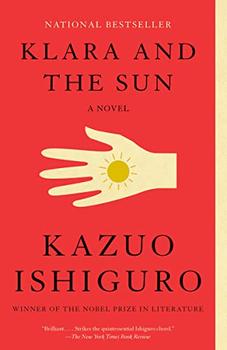Summary | Excerpt | Reading Guide | Discuss | Reviews | Beyond the book | Read-Alikes | Genres & Themes | Author Bio

Klara and the Sun by Nobel Prize-winning author Kazuo Ishiguro drops the reader into a fictional universe that could be our own, save for scientific developments that have changed the course of events in drastic ways. For those familiar with Ishiguro's previous works, being placed in this type of altered and somewhat mysterious parallel reality will be familiar.
The story is told from the perspective of Klara, an Artificial Friend (AF). Klara is uncommonly bright for an AF, and catches the eye of her future companion, a girl named Josie, while displayed in a store window. Unlike many other AFs, Klara possesses an uncanny knack for observation and understanding. Though Josie immediately chooses Klara, her mother must be persuaded to take Klara home with them. The plot appears to take place in the not-so-distant future, and Josie's mother's reluctance mirrors a broader reticence toward AFs amongst older generations in society.
Some aspects of the novel's world are concealed; as in Ishiguro's Never Let Me Go, many facets of reality are merely hinted at, glossed over or elusive until later, if not for the entire story. For example, children and adolescents are educated virtually from their respective homes; and by way of some unclear alteration, some are "lifted" and receive special access to quality education, while others are not. However, unlike Never Let Me Go, Klara and the Sun focuses on the sacrifices and inner lives not of human beings, but of artificial intelligence (AI).
What is perhaps most disturbing about the story is its proximity to the current state of the world in the time of COVID-19. AFs accompany some adolescent children in order to assuage the loneliness they feel due to relative isolation from others their age, the reasons for which are not obvious. Children learn via "oblongs," which appear to be like smart tablets, and virtual tutors who instruct them from their homes. They must attend "socialization" events organized by their parents to develop social skills and interact with peers, but rarely see anyone other than their own parents and AFs in person. Indeed, it can feel like the story is a little too on the nose given our present circumstances.
While the uneasy mood of Klara and the Sun is partly due to these blatant parallels to today's world, it also results from the novel's somewhat traditional depiction of the relationship between humans and AI. On this front, Ishiguro's work does not break any new ground; the tensions present in many other stories are implicit here, too. Can AI feel? Can they love or have genuine experiences that we would recognize as human? Can they have faith or experience loyalty? These questions have formed the basis of countless works of science fiction. Even Klara's ostensibly uncommon curiosity is a well-worn trope present in many similar investigations into the nature of AI.
Yet despite drawing on previously explored themes, Ishiguro is generally able to avoid falling into cliché. This is partly because of the emphasis the author places on faith. AFs are solar powered, and exercise a sort of belief in the sun that resembles religious worship, largely stemming from it being their source of energy. Klara views the sun as an omnipotent force capable of healing humans and AFs alike. This allows for a degree of spirituality not often seen in stories about AI, and imbues Klara's experiences and outlook with a very human inclination.
One of the questions central to the story is whether human beings really do contain some ineffable quality that cannot be replicated artificially. The answer, perhaps reassuringly, is that yes, regardless of how advanced or studied AI becomes, there will always be a certain humanness that cannot be reproduced outside of a person. However, that difference is not in the capacity for love, faith, loyalty or empathy, as is demonstrated through Klara's experiences.
In Klara and the Sun, Ishiguro has designed neither a utopia nor a dystopia. Compellingly, it is a world much like our reality, one that augments and is augmented by technology in ways that are frightening and exhilarating. While the novel invokes recognizable philosophical queries, the author's characteristic melancholy and relatable use of memory and empathy reinvigorate otherwise tired concepts. It is unlikely that readers will tire of the seemingly endless nuances inherent to possible relationships between AI and humans anytime soon, but it is Ishiguro's inimitable storytelling that sets this story apart from its thematic predecessors.
![]() This review was originally published in The BookBrowse Review in March 2021, and has been updated for the
March 2022 edition.
Click here to go to this issue.
This review was originally published in The BookBrowse Review in March 2021, and has been updated for the
March 2022 edition.
Click here to go to this issue.

If you liked Klara and the Sun, try these:

by Ali Smith
Published 2025
From a literary master, a moving and genre-bending story about our era-spanning search for meaning and knowing.

by Lindsey Drager
Published 2024
At once an ode to birds, an elegy to space, and a journey into the most haunted and uncanny corners of the human mind, The Avian Hourglass showcases Lindsey Drager's signature brilliance in a stunning, surrealist novel for fans of Jesse Ball, Helen Oyeyemi, Yoko Ogawa, and Shirley Jackson.
Beware the man of one book
Click Here to find out who said this, as well as discovering other famous literary quotes!
Your guide toexceptional books
BookBrowse seeks out and recommends the best in contemporary fiction and nonfiction—books that not only engage and entertain but also deepen our understanding of ourselves and the world around us.